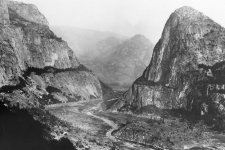The opening sequence of Deliverance shows the construction of the dam that forms Lake Jocassee. The book and movie took their inspiration from the destruction of South Eastern rivers.
The dam inundated parts of the Keowee River, Toxaway River, Whitewater River, Thompson River, and Horse Pasture River. The remaining upper valleys are possibly the most rugged and beautiful in the East.
The Keowee river continued south, but is now completely inundated by Lake Keowee. Judging from the topographical maps it must have been a beautiful open boat run.
I heard a first-hand account of running the lower Toxaway River Gorge before the dam was constructed. The gorge was beautiful, but the raft was destroyed and they had to hike out.
Whippoorwill Farewell, by Debbie Fletcher, recounts the Jocassee Valley, mostly the Whitewater River area. It's interesting for its pictures of the lower Whitewater River, including tubing and polling some kind of long rectangular river craft.
Does anyone have any recommendations for reading about drowned rivers?
The dam inundated parts of the Keowee River, Toxaway River, Whitewater River, Thompson River, and Horse Pasture River. The remaining upper valleys are possibly the most rugged and beautiful in the East.
The Keowee river continued south, but is now completely inundated by Lake Keowee. Judging from the topographical maps it must have been a beautiful open boat run.
I heard a first-hand account of running the lower Toxaway River Gorge before the dam was constructed. The gorge was beautiful, but the raft was destroyed and they had to hike out.
Whippoorwill Farewell, by Debbie Fletcher, recounts the Jocassee Valley, mostly the Whitewater River area. It's interesting for its pictures of the lower Whitewater River, including tubing and polling some kind of long rectangular river craft.
Does anyone have any recommendations for reading about drowned rivers?


